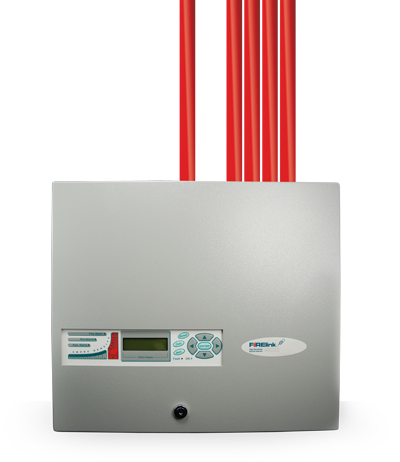FIRElink
An Overview of Hochiki's High Sensitivity Air Sampling System.
An Overview of Hochiki's High Sensitivity Air Sampling System.
Introduction
For environments such as computer areas, cold stores and clean rooms, the FIRElink range is able to give warning to the very slightest trace of smoke. All detectors in the FIRElink range have been approved to EN54-20:2006 Classes A, B & C by LPCB.

Benefits

Sensitive
The lased based detector and sampling pipe allow for high sensitivity air sampling.

ESP Compatible
Fully integrated into Hochiki's renowned ESP intelligent hardwired system, providing maximum flexibility.

Expandable
Offering a fully expandable and configurable system suitable to a wide range of applications.

Simple Installation
Easy to install due to its flexibility and versatility for many environments utilising the air sampling pipes.
Features

Air Sampling Fire Detection
An Air Sampling Fire Detection System is one which utilises the suction of air in conjunciton with small pipe work to sample the air for smoke. Air sampling detection is up to 200 times the sensitivity of a point detector.

How Air Sampling Works
With strategically placed pipes and sampling holes, an air impeller can sample the air by drawing it along the pipe and into the detector measuring chamber. This aspirating smoke detection system is designed to provide an extremely high level of sensitivity to smoke detection, therefore detecting smoke at an earlier stage in the developement of a fire.

Where Air Sampling Can Be Used
Capillary sampling is a method of locating smoke sampling points remote from the main sampling pipe. This is particularly useful where the main sampling pipe cannot be routed through the area requiring protection for either technical or aesthetic reasons. The actual capillary sampling point assembly may be known as a ‘remote sampling point' or ‘extended sampling point'. The technique uses short lengths of flexible tubing that branches off from the main sampling pipe.The end of the flexible tube is fitted with an assembly to achieve the desired air flow rate for the application.

False Alarm Reduction
With the high sensitivity of air sampling systems, there is an increased chance of false alarms. However, with Hochiki FIRElink, false alarms are reduced by unique dust discrimination. Threshold levels can be set, indicating large dust particles into the scattering volume.

High Sensitivity Sampling
High sensitivity air sampling is provided by the obscuration method, and when a pre-defined density of smoke appears in the chamber, the system will go into alarm.

Return Register & Duct Sampling
Sampling air at return air registers and in extract air ducts is an effective, convenient and flexible method of detecting smoke from protected areas that have a constant air flow created by mechanical air handling plant. Typical examples - computer, telephone switch rooms, micro-electronics clean rooms, atrium and auditorium areas, etc. This method of sampling can effectively protect large volumes at a relatively low cost. It can also offer unobtrusive coverage, which may be essential for some applications. Duct sampling uses a sampling pipe or ‘duct probe' which penetrates a return air duct in such a way that the sampling holes are placed directly in the path of the air flow. An air sample is taken by the duct probe and drawn back to the detector.

Expandable & Configurable
Dilution can be a potential problem if the pipe design has not been carefully considered. With FIRElink, pipe work is customisable to help allocate sampling holes in specific locations for precision, accuracy and efficiency in the sampling.
Applications
The FIRElink system is adaptable to a broad range of environments and applications. From small, to very large areas, the system can be designed to fit almost any particular environment. Such as -
Enquire now
To contact us please fill out the form below